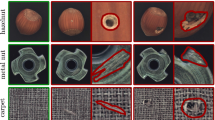Abstract
Recompression is a prevalent form of multimedia content manipulation. Different approaches have been developed to detect this kind of alteration for digital images of well-known JPEG format. However, they are either limited in performance or complex. These problems may arise from different quality level options of JPEG compression standard and their combinations after recompression. Inspired from semantic and perceptual analyses, in this paper, we suggest a part-level middle-out learning strategy to detect double compression via an architecturally efficient classifier. We first demonstrate that singly and doubly compressed data with different JPEG coder settings lie in a feature space representation as a limited number of coherent clusters, called parts. To show this, we visualize behavior of a set of prominent Benford-based features. Then, by leveraging such discovered knowledge, we model the issue of double JPEG compression detection in the family of feature engineering-based approaches as a part-level classification problem to cover all possible JPEG quality level combinations. The proposed strategy exhibits low complexity and yet comparable performance in comparison to related methods in that family. For reproducibility, our codes are available upon request to fellows.




Similar content being viewed by others
References
Alipour N, Behrad A (2020) Semantic segmentation of JPEG blocks using a deep CNN for non-aligned JPEG forgery detection and localization. Multimed Tools Appl, pp 1–17
Bianchi T, Piva A (2012) Image forgery localization via block-grained analysis of JPEG artifacts. IEEE Trans Inf Forensics Security 7(3):1003–1017
Chang CC, Lin CJ (2011) LIBSVM: A library for support vector machines. ACM T Intel Syst Tec 2(3), article 27
Cheng H, Liu Z, Yang L, Chen X (2013) Sparse representation and learning in visual recognition: Theory and applications. Signal Process 93 (6):1408–1425
Dalal N, Triggs B (2005) Histograms of oriented gradients for human detection. IEEE CVPR 1:886–893
Dong L, Kong X, Wang B, You X (2011) Double compression detection based on Markov model of the first digits of DCT coefficients. In: IEEE ICIG, pp 234–237
Farid H (2009) Image forgery detection. IEEE Signal Process Mag 26(2):16–25
Felzenszwalb P F, Girshick R B, McAllester D, Ramanan D (2010) Object detection with discriminatively trained part-based models. IEEE Trans Pattern Anal Mach Intell 32(9):1627–1645
Fridrich J (2009) Digital image forensics. IEEE Signal Process Mag 26(2):26–37
Galvan F, Puglisi G, Bruna A, Battiato S (2014) First quantization matrix estimation from double compressed JPEG images. IEEE Trans Inf Forensics Security 9(8):1299–1310
Hsu C W, Lin C J (2002) A comparison of methods for multiclass support vector machines. IEEE Trans Neural Netw 13(2):415–425
Huang X, Wang S, Liu G (2018) Detecting double JPEG compression with same quantization matrix based on dense CNN feature. In: IEEE ICIP, pp 3813–3817
Li B, Shi YQ, Huang J (2008) Detecting doubly compressed JPEG images by using mode based first digit features. In: IEEE MMSP, pp 730–735
Li B, Zhang H, Luo H, Tan S (2019) Detecting double JPEG compression and its related anti-forensic operations with CNN. Multimed Tools Appl 78(7):8577–8601
Liu J, Ji S, Ye J (2011) SLEP: Sparse learning with efficient projections. Arizona State University
Liu Q, Sung A H, Qiao M (2011) A method to detect JPEG-based double compression. In: ICANN, Lect. Notes Comput. Sc., Part II, pp 466–476
Liu Q, Sung A H, Qiao M (2011) Neighboring joint density-based JPEG steganalysis. ACM T Intel Syst Tec 2(2), article 16
Lukáš J, Fridrich J (2003) Estimation of primary quantization matrix in double compressed JPEG images. In: DFRWS
van der Maaten L, Hinton G (2008) Visualizing data using t-SNE. J Mach Learn Res 9:2579–2605
Milani S, Tagliasacchi M, Tubaro S (2014) Discriminating multiple JPEG compressions using first digit features. APSIPA Trans Signal Inf Process 3
Olmos A, Kingdom F A A (2004) A biologically inspired algorithm for the recovery of shading and reflectance images. Perception 33(12):1463–1473
Piva A (2013) An overview on image forensics. ISRN Signal Process Article ID 496701
Popescu AC, Farid H (2004) Statistical tools for digital forensics. In: IWIH, pp 128–147
Richtsfeld A, Mörwald T, Prankl J, Zillich M, Vincze M (2014) Learning of perceptual grouping for object segmentation on RGB-D data. J Vis Commun Image R 25(1):64–73
Taimori A, Razzazi F, Behrad A, Ahmadi A, Babaie-Zadeh M (2016) Quantization-unaware double JPEG compression detection. J Math Imaging Vis 54(3):269–286
Taimori A, Razzazi F, Behrad A, Ahmadi A, Babaie-Zadeh M (2017) A novel forensic image analysis tool for discovering double JPEG compression clues. Multimed Tools Appl 76(6):7749–7783
Yang J, Xie J, Zhu G, Kwong S, Shi Y Q (2014) An effective method for detecting double JPEG compression with the same quantization matrix. IEEE Trans Inf Forensics Security 9(11):1933–1942
Zhang C, Cheng J, Liu J, Pang J, Liang C, Huang Q, Tian Q (2014) Object categorization in sub-semantic space. Neurocomputing 142:248–255
Author information
Authors and Affiliations
Corresponding author
Additional information
Publisher’s note
Springer Nature remains neutral with regard to jurisdictional claims in published maps and institutional affiliations.
Rights and permissions
About this article
Cite this article
Taimori, A., Razzazi, F., Behrad, A. et al. A part-level learning strategy for JPEG image recompression detection. Multimed Tools Appl 80, 12235–12247 (2021). https://doi.org/10.1007/s11042-020-10200-4
Received:
Revised:
Accepted:
Published:
Issue Date:
DOI: https://doi.org/10.1007/s11042-020-10200-4




